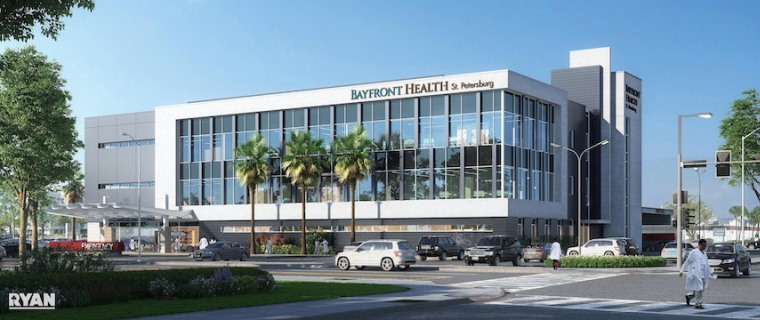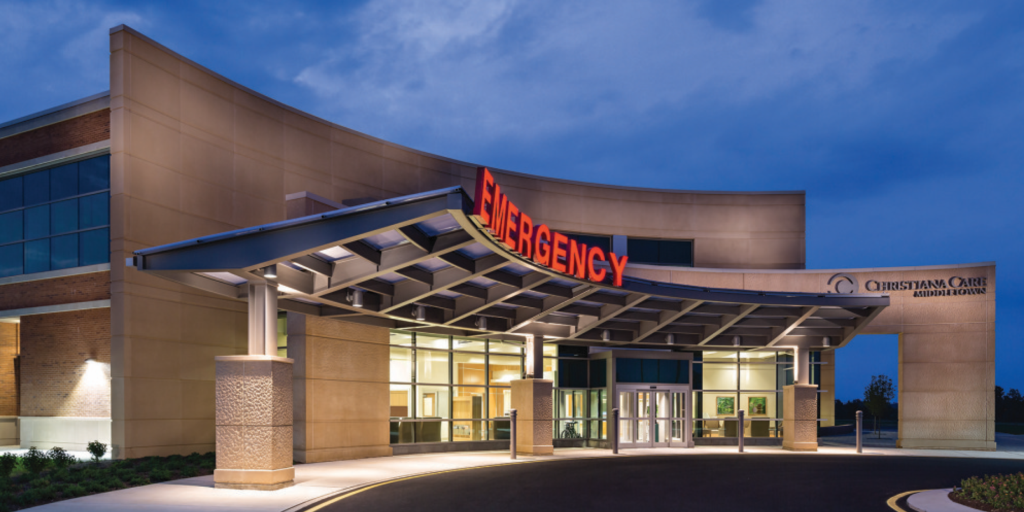Residents on the west side of St. Petersburg will soon have easier access to medical care thanks to Bayfront Health’s new state-of-the-art, $37 million facility currently under construction in the Crossroads neighborhood.
City and county officials joined leadership from Bayfront Health St. Petersburg and its parent company, Orlando Health, on March 26 to commemorate the completion of the foundation for the new Bayfront Health Emergency Room & Medical Pavilion – Crossroads. The four-acre site at 1800 66th St. N. will feature a three-story, 42,000-square-foot facility with a 14,000-square-foot emergency room on the ground floor. According to a release, the emergency department will include 12 exam rooms, two resuscitation rooms, six waiting areas and an ambulance bay.
Bayfront Health purchased the property, formerly home to a Department of Motor Vehicles (DMV) facility, in March of 2021. After partnering with Ryan A+E, Inc. and the City of St. Petersburg on a master plan, construction crews broke ground on the site in February. After congratulating all of the project’s stakeholders, Pinellas County Commission Chair Charlie Justice joked that it was also a sad day due to his nostalgic memories of waiting at the former DMV for hours.
“In Pinellas County, we have 24 cities and nearly a million people,” he said. “We know nothing happens without good partners and partnerships, and healthcare for a million people in Pinellas County is also a partnership.
“We’re incredibly grateful for Bayfront Health expanding their reach beyond their scope to now come out to the west side.”
Deputy Mayor Stephanie Owens said her experience in several levels of government, including two presidential administrations, provided a broad perspective on a variety of issues – especially health care. The most important work, she said, takes place locally in communities like St. Pete and through projects like the Crossroads Medical Pavilion.
Owens said the ceremony was more than a celebration for a concrete foundation as it highlighted continued investment in the city’s communities.
“As our city continues to grow, so does the need for increased services,” she added. “It’s partnerships like this that make me excited for the future of the city.”
City Councilmember Copley Gerdes represents District 1, which encompasses the site of the future medical pavilion. He also grew up less than a mile away and said he could hit a golf ball to his current home. Gerdes reminisced of playing sports in the area with his family as a child, which provided many opportunities for minor injuries. He said his family would soon have a shorter distance to travel when seeking care for future mishaps.
Gerdes also noted the large construction site for a new development was an unaccustomed view for residents on the west side of the city and said he hopes it spurs further growth.
“I really have a belief that a building like this can be the anchor for continued development on the west side of St. Petersburg,” he said. “And the great part about that is … giving quality healthcare to our side of town, as well.”
Dr. Traci Ryan, medical director for Bayfront Health’s emergency facilities, told the Catalyst that the Bayfront Health St. Petersburg Emergency Room would provide emergency medical care for those living within a 10-mile radius of the site. She said the organization’s closeness with the surrounding community sets it apart from other healthcare providers, and she also noted that many employees grew up in the area.
Ryan said Bayfront focuses on fostering good relationships between its patients and providers and makes a conscientious effort to quickly move patients through its emergency facilities.
“Nobody wants to spend their day in E.R.,” she added. “Generally, our wait times at our freestanding (clinics) are five or 10 minutes, and you’re in and out in … 120 minutes to less than 90 minutes.”
Bayfront Health St. Petersburg has provided health services for the city since 1910, and officials expect the Crossroads Emergency Room & Medical Pavilion to open in the spring of 2023.
Source: St. Pete Catalyst


